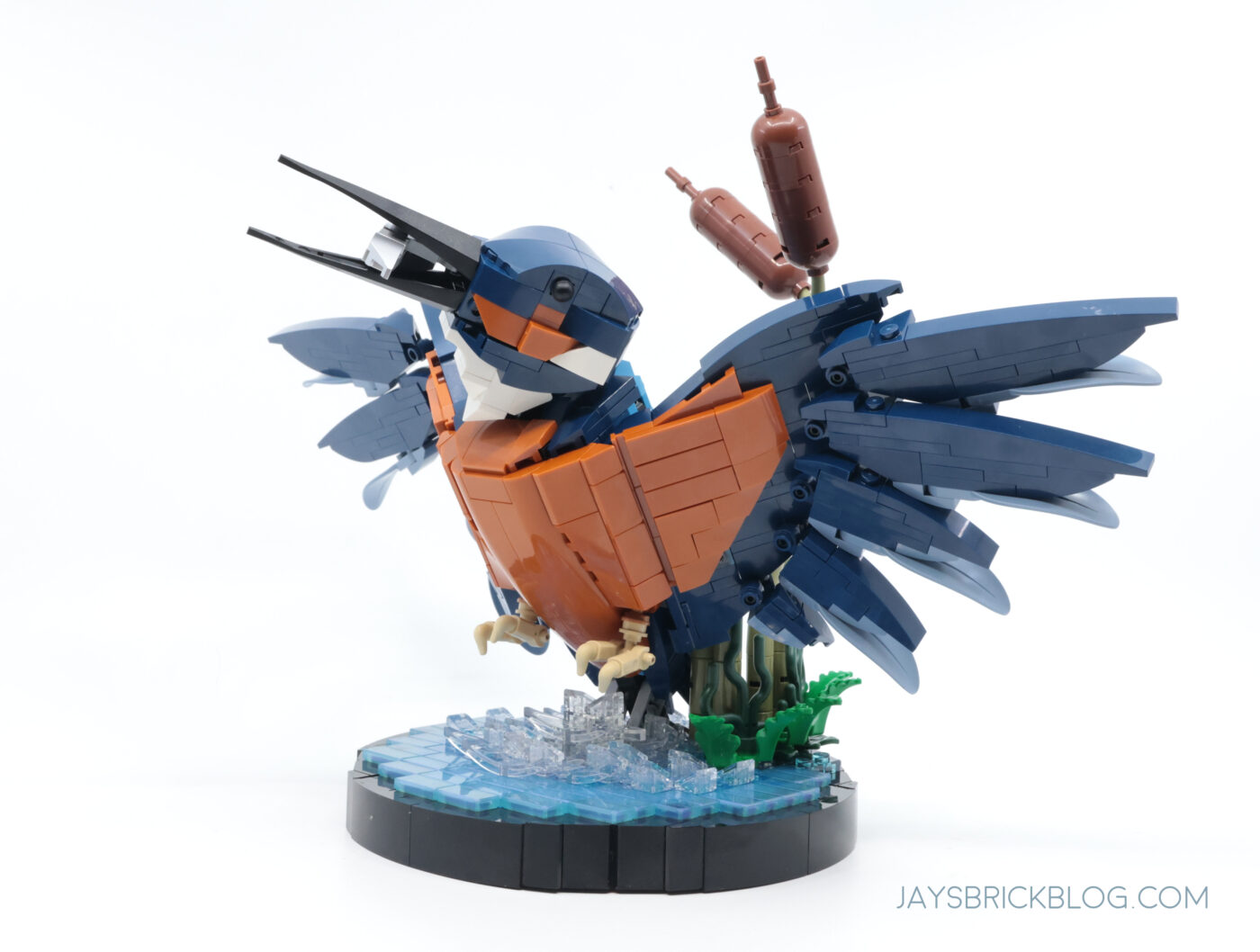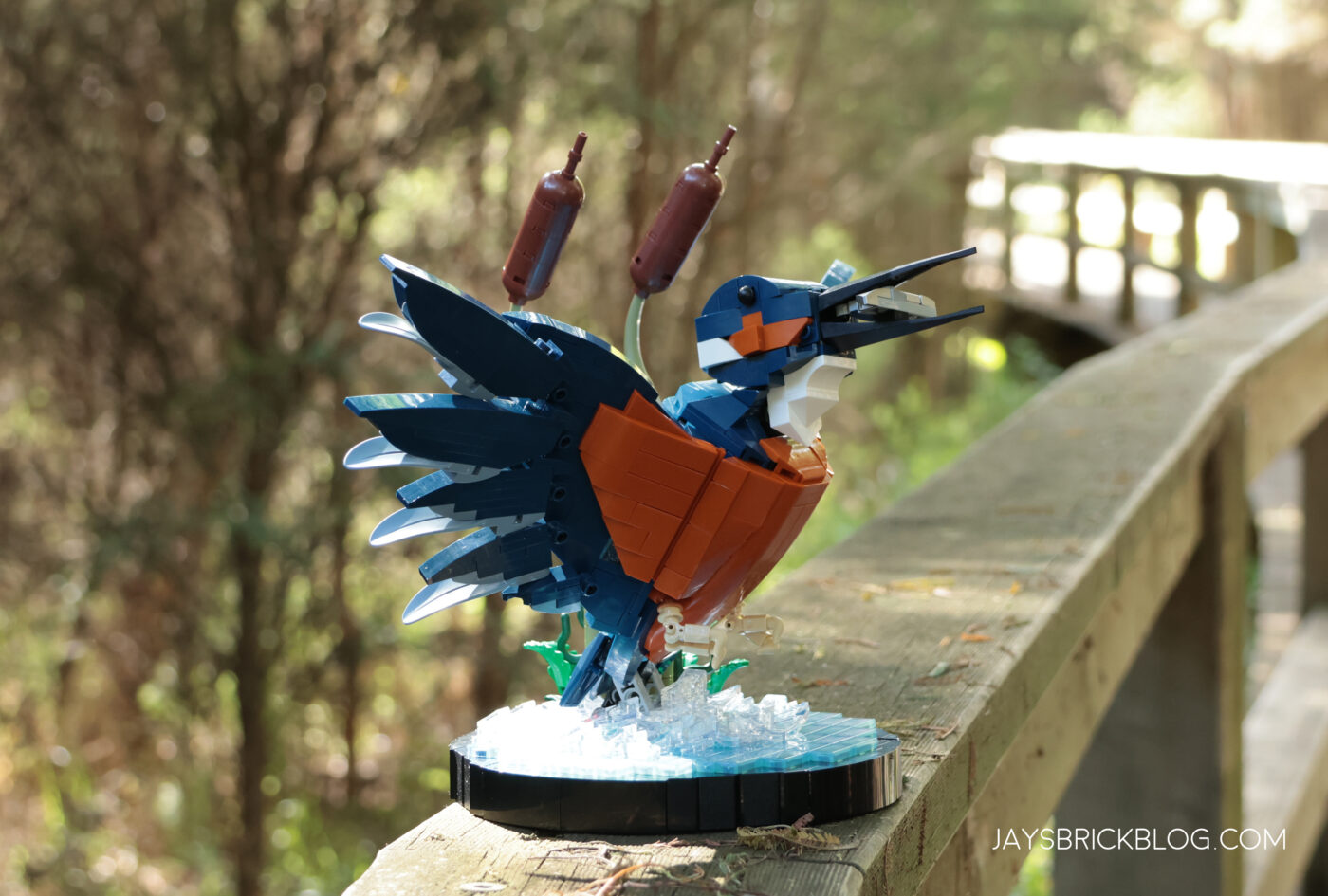Review: LEGO 10331 Kingfisher Bird
 4
4

The LEGO Fauna Collection takes flight in 2024, with LEGO Icons stepping into the animal world with 10331 Kingfisher Bird, the very first animal-themed model.
The LEGO Kingfisher is based on the Azure Kingfisher, which is native to Australia, so this one feels very close to home and is designed to appeal to birdwatchers and fans of these iridescent beauties, which you may spot near waterways and lakes if you’re lucky.
Think of 10331 Kingfisher Bird as a natural extension to LEGO’s famed Botanical Collection, and is a great introduction into the possibilities of a LEGO Icons theme filled with highly detailed and realistic animal models.
Ahead of its release on 1 February 2024, here’s a quick review of the LEGO Kingfisher Bird!
See below for regional pricing and product pages
- 10331 Kingfisher Bird [US] – US$49.99
- 10331 Kingfisher Bird [AUS] – AU$89.99 [LEGO Certified Store]
- 10331 Kingfisher Bird [UK] – £44.99
- 10331 Kingfisher Bird [EU] – €49.99
- 10331 Kingfisher Bird [CA] – CAD$69.99
Who is this set for? LEGO fans that like birds and kingfishers and want a small, but aesthetic-looking model that blends well with other Botanical sets.
If you’re thinking of ordering the LEGO Kingfisher, please consider using these affiliate links as I may receive a small commission with each purchase that helps support the work I do here on the blog.
Special thanks to LEGO for sending this set for this review!
10331 Kingfisher Bird Set Details

Name: Kingfisher Bird
Set Number: 10331
Pieces: 834 pieces
Price: US$49.99 / AU$89.99 / £44.99 / €49.99 / CAD$69.99
Exclusive to: N/A
Theme: Icons
Release Date: 1 February 2024
LEGO Designer: Sven Franic
Unboxing and Build Experience


Here’s a look at the insides of the instruction manual, which has a few pages dedicated to tidbits of information about the Azure Kingfisher which is what the model is based on.
A funny thing I picked up is that it mentions that the Azure Kingfisher is native to Australia and Tasmania. Tasmania, is of course, a state in Australia, so that mention feels kinda redundant, but also quite fitting, generally as people tend to leave Tasmania out of maps or mentions of Australia (there’s even a Wiki article on this if you don’t believe me!), so this feels like someone who wrote it maybe thought Tasmania is a separate entity.

Oh and naturally, there are no stickers in the set.
The Build Experience

I don’t usually do this, but felt like I need to pad out this review a bit more, so I decided (unwisely) to knoll out and photograph the elements found in all 5 numbered bags of the set.
Unwisely because knolling is an artform that requires patience, persistence and a steady hand, 3 virtues that I lack! Plus, it’s a lot of work, but I thought it would be a nice visual guide to see how a bunch of random LEGO elements come together to create an organic form like the Azure Kingfisher.

Bag 1 builds the base. For an organic build, the first bag is surprisingly geometric and a little technical, with some slightly advanced techniques.



Bag 2 completes the base and water detail, and Bag 3 starts off the Kingfisher’s body.




And here’s Bag 4 and 5, where you finish of the build with the wings, head and the reeds.
The Completed Model

And here’s the completed LEGO Kingfisher, frozen in a moment in time as it emerges from the water with a fish in its beak, with its wings stretched out in a dramatic pose.
The build experience was quite enjoyable, and while we’ve had plenty of great animals models in the LEGO Creator theme, being nested within LEGO Icons gives this a much more polished, advanced build experience.
It’s a simple, yet cunningly tricky model and when you see the Kingfisher slowly take shape from a bunch of LEGO elements on your table, you really appreciate the design talent that was involved in making this set a possibility.

The Kingfisher’s pose is what makes the entire model, and it makes for a visually exciting and interesting model that’s made for display. Despite looking like its frozen in time, it tells a rich visual story and is a potent showcase of what’s possible with LEGO bricks.

The wings are one of the highlights, and I like how they fan out in an organic manner, as well as the use of dark blue and sand blue elements for the feathers on the edge of the wing – while it doesn’t quite do the Azure Kingfisher’s iridescent features justice, the silhouette works well here.

Here’s a look at the underside.

No LEGO set is perfect, and it’s only when you zoom into the details that some of the flaws begin to appear. For one thing, there’s something about the eye that doesn’t quite sit right – I think they’re positioned a bit too high relative to the beak, which makes the head look quite off.
There’s also half a hollow stud peeking out near the beak, which is quite jarring when most of the model has near-flawless shaping and sculpting. This slightly exposed stud feels very out of place.

I do like how the head is constructed otherwise, as well as the great element choice for the beak, and drum-lacquered silver elements for the fish.

I also don’t quite like the mass of studs on the back. Texturally, they make sense, as the feathers tend to tuft out here, but I do wish this was completely smooth.

Here’s how it looks from the back. I do like the reeds and some botanical elements on the side, which not only provide some visual balance, and a sense of nature, but also serve as a great tool to establish a sense of scale.

Here’s a look at the water details, agitated as the Kingfisher rises from it with its prize.

The generous inclusion of so many of these pagoda roof tiles (which made its debut in 21060 Himeji Castle) in trans-clear for the first time should excite LEGO element fans.

Another slight nitpick is the legs, which seem like the wrong colour. The tan elements used does make sense to create a sense of contrast, which I suspect was why they were chosen, but it isn’t the most accurate, at least when I pored over dozens of photographs of Azure Kingfishers.

And here it is next to the LEGO Bonsai Tree. I deliberately placed these two side by side as the LEGO Bonsai Tree heralded a new era of LEGO Botanicals when it launched in early 2021.
Here’s hoping that the Kingfisher also kicks off an exciting new animal chapter for LEGO Icons in the same vein as the Bonsai Tree.
I also placed them side by side as they’re both priced the same (US$49.99/AU$99.99 respectively), just to demonstrate that while the LEGO Kingfisher isn’t the most cheapest set, it does feel like good value and looks very substantial on display.
The LEGO Kingfisher out in nature

Azure Kingfishers are beloved by birdwatchers and photographers, so I also decided to put it to the test, and see how it looks like out in nature.
I had a wonderful afternoon in my local wetlands park with the LEGO Kingfisher, and can confidently say that it does look great in nature – a testament to the design of the set, and how realistic it can look at certain angles.





And yes, I even placed it in a creek to see how it looks like emerging from the water with a freshly caught fish!
It did kick up plenty of silt that enveloped the base, but it was worth it to get the shot!
What I liked:
- A fun and novel build experience that’s enjoyable for both veteran and new LEGO fans
- Looks superb on display with attractive plumage and colours
- Feels like good value for its display presence and build experience
What I didn’t like:
- Eyes and exposed stud in the head feel a little weird
- Colour of legs aren’t the best choice
- Quite a static model
FINAL THOUGHTS:
For fans of LEGO Icons, 10331 Kingfisher Bird is a pretty good introduction to the new Fauna Collection, and makes me intrigued and excited for what other animals or creatures LEGO has up its sleeve for LEGO Icons.
The similarities between the LEGO Botanicals are hard to miss, with realism and a dynamic display model being the primary design objectives, which the LEGO Kingfisher does excel at.
The dramatic pose, relatively small footprint, and the fact that it’s a life-sized, convincingly life-like take on one of the most recognisable birds doing its most recognisable pose is to be praised, especially when you go through the entire build experience where you can appreciate just how elegant and well-designed of a model this is.
Some of the flaws I pointed out, like the eyes looking like they’re in a weird position and the legs being the wrong colour will only matter if you’re an ardent bird fan or birdwatcher, but to the general public, I think these compromises will likely not matter as much.
10331 Kingfisher Bird is a superb display model, very fun to build and a great addition to your nature-inspired LEGO displays, which by now should be bursting with LEGO Flowers and Botanicals.
Adding animals and creatures to the mix definitely makes sense from a theme extension, and I’m hopeful to see more birds, but I can also see some more interesting animals like Chameleons, or sugar gliders or even cephalopods in this format. We are getting a Cat soon in LEGO Ideas too!
At US$49.99/AU$99.99, 10331 Kingfisher Bird won’t break the bank, especially if you can wait for an inevitable sale on Amazon or other toy retailers, and this will provide a wonderful afternoon of building, and leave you with an attractive display model of the Azure Kingfisher.
Rating and score: 4/5 ★★★★☆
Build [4] – A fun, inviting and interesting build experience that will appeal to all builders
Real Value [4] – Glad they’ve stuck to the same price range as Botanicals, and this one feels substantial from a display perspective
Innovation [4] – Great to see LEGO move away from plants and flowers to take on hyper-realistic animals.
Coolness [4] – If you enjoy birdwatching or kingfishers, and want a unique display model, the LEGO Kingfisher will tick the coolness box
Keepability [4] – Easy to display and incorporate into your other Botanicals, or as a standalone in a living space
Thanks so much for reading my review of the LEGO Kingfisher!
10331 Kingfisher Bird will be available from LEGO.com or your local LEGO Store from 1 February onwards.
What do you think of the LEGO Kingfisher? What other animals or birds would you like to see from LEGO next?
To get the latest LEGO news and LEGO Reviews straight in your inbox, subscribe via email, or you can also follow on Google News, or socials on Facebook, Instagram (@jayong28), Twitter or subscribe to the Jay’s Brick Blog Youtube channel.







